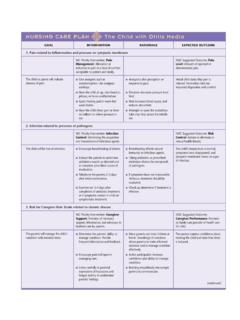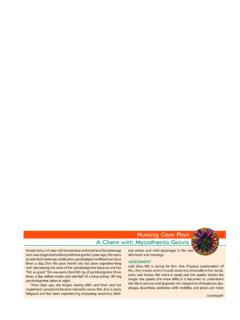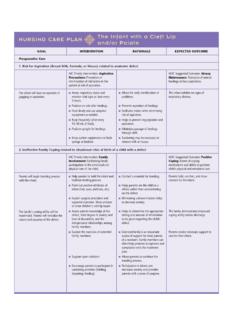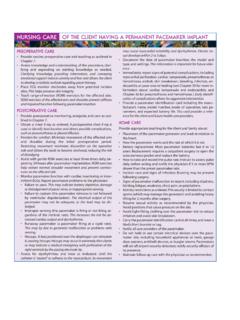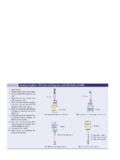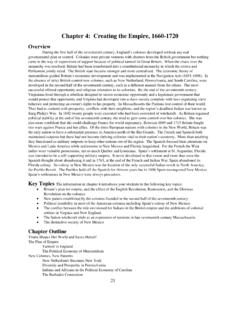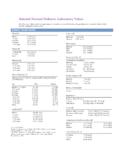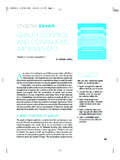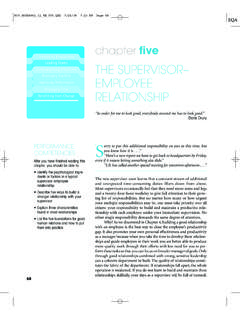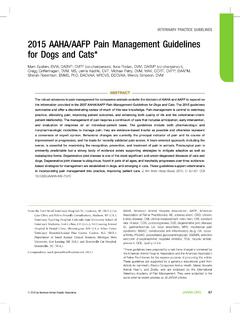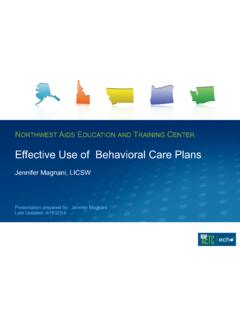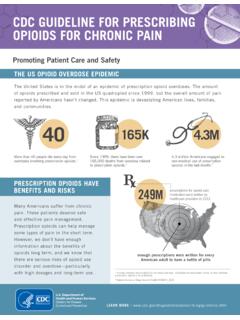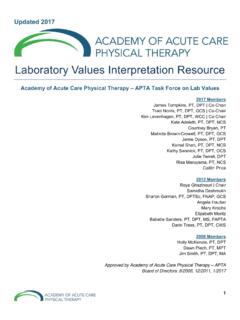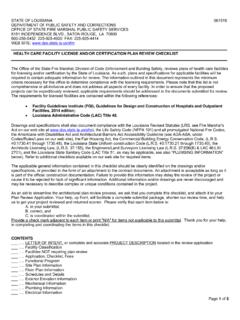Transcription of NURSING CARE PLAN Acute Pain - Savvas
1 11/8/06 6:21 PM Page 1223. CHAPTER 46 / pain Management 1223. Were the client's beliefs, expectations, and values about pain CLINICAL ALERT therapy considered? The statement Please tell me how I can best help you control your pain Did the client understate the pain experience for some reason? sends a couple of subtle messages that are an important part of treat- Were appropriate instructions provided to allay misconcep- ment planning and evaluation of care . First, it places the ownership and tions about pain management? responsibility for controlling pain on the client. Second, it acknowledges Did the client and support people understand the instructions that the client may be the best judge of what is needed, respecting the cultural meaning of pain and acceptable ways of expressing/controlling about pain management techniques?
2 pain . Third, it establishes the nurse's role in helping the client be more Is the client receiving adequate support for both physical comfortable and in control of his or her condition. pain and emotional distress? Has the client's physical condition changed, necessitating modifications in interventions? If outcomes are not achieved, the nurse and client need to ex- Should selected intervention strategies be reevaluated? plore the reasons before modifying the care plan . The nurse might consider the following questions: See the NURSING care plan and the Concept Map. Is adequate analgesic being given? Would the client benefit from a change in dose or in the time interval between doses? CRITICAL THINKING CHECKPOINT. Mrs. Lundahl underwent abdominal surgery approximately 6 hours ago.
3 1. What conclusions, if any, can be drawn about Mrs. Lundahl's pain She has a 15-cm midline incision that is covered with a dry and intact status? surgical dressing. Upon assessing Mrs. Lundahl you note that she is per- 2. Does Mrs. Lundahl's rating her pain as 5 mean that she is not ex- spiring, lying in a rigid position, holding her abdomen, and grimacing. periencing pain severe enough to warrant intervention? Her blood pressure is 150/90, heart rate 100, and respiratory rate 32. 3. What type of pain is Mrs. Lundahl experiencing? When asked to rate her pain on a scale of 0 to 10, Mrs. Lundahl rates 4. What interventions, in addition to pain medication, may be use- her pain as 5 as long as she remains perfectly still. There is a sharp area ful in reducing Mrs.
4 Lundahl's pain ? of pain at her incision; however, the most bothersome pain is crampy 5. How will you know if your interventions have been effective in and dull, like she was kicked in the stomach with severe exacerbations reducing Mrs. Lundahl's pain ? that come in unpredictable waves. See Critical Thinking Possibilities in Appendix A. NURSING care plan Acute pain ASSESSMENT DATA NURSING DIAGNOSIS DESIRED OUTCOMES*. NURSING Assessment Acute pain related to tissue in- pain Control [1605] as evi- Mr. C. is a 57-year-old businessman who was admitted to the sur- jury secondary to surgical inter- denced by often demonstrating gical unit for treatment of a possible strangulated inguinal hernia. vention (as evidenced by ability to Two days ago he had a partial bowel resection.)
5 Postoperative or- restlessness; pallor; elevated Use analgesics appropriately ders include NPO, intravenous infusion of D51/2 NS at 125 cc/hr pulse, respirations, and systolic Use nonanalgesic relief left arm, nasogastric tube to low intermittent suction. Mr. C. is in a blood pressure; dilated pupils; measures dorsal recumbent (supine) position and is attempting to draw up and report of 7/10 abdominal Report uncontrolled his legs. He appears restless and is complaining of abdominal pain ) symptoms to health care pain (7 on a scale of 0 10). professional pain Level [2102] As evi- Physical Examination Diagnostic Data denced by mild to no Height: 188 cm (6 3 ) Chest x-ray and urinalysis neg- Reported pain Weight: kg (200 lb) ative, WBC 12,000 Protective body positioning Temperature: 37 C ( F) Restlessness Pulse: 90 BPM Pupil dilation Respirations: 24/minute Perspiration Blood pressure: 158/82 mm Hg Change in BP, HR, R from Skin pale and moist, pupils di- normal baseline data lated.
6 Midline abdominal inci- sion, sutures dry and intact. continued on page 1224. 11/8/06 6:21 PM Page 1224. 1224 UNIT X / Promoting Physiologic Health NURSING care plan Acute pain continued NURSING INTERVENTIONS*/SELECTED ACTIVITIES RATIONALE. pain Management [1400]. Perform a comprehensive assessment of pain to include location, pain is a subjective experience and must be described by the characteristics, onset, duration, frequency, quality, intensity or client in order to plan effective treatment. severity, and precipitating factors of pain . Consider cultural influences on pain response ( , cultural beliefs Each person experiences and expresses pain in an individual about pain may result in a stoic attitude). manner using a variety of sociocultural adaptation techniques.
7 Reduce or eliminate factors that precipitate or increase Mr. C.'s Personal factors can influence pain and pain tolerance. Factors pain experience ( , fear, fatigue, monotony, and lack of that may be precipitating or augmenting pain should be reduced knowledge). or eliminated to enhance the overall pain management program. Teach the use of nonpharmacologic techniques ( , relaxation, The use of noninvasive pain relief measures can increase the re- guided imagery, music therapy, distraction, and massage) before, lease of endorphins and enhance the therapeutic effects of pain after, and if possible during painful activities; before pain occurs or relief medications. increases; and along with other pain relief measures. Provide Mr.
8 C. optimal pain relief with prescribed analgesics. Each client has a right to expect maximum pain relief. Optimal pain relief using analgesics includes determining the preferred route, drug, dosage, and frequency for each individual. Medica- tions ordered on a prn basis should be offered to the client at the interval when the next dose is available. Medicate before an activity to increase participation, but evaluate Turning and ambulation activities will be enhanced if pain is con- the hazard of sedation. trolled or tolerable. Assessing level of sedation should precede the activity to ensure necessary safety precautions are put in place. Evaluate the effectiveness of the pain control measures used Research shows that the most common reason for unrelieved through ongoing assessment of Mr.
9 C.'s pain experience. pain is failure to routinely assess pain and pain relief. Many clients silently tolerate pain if not specifically asked about it. Analgesic Administration [2210]. Check the medical order for drug, dose, and frequency of anal- Ensures that the nurse has the right drug, right route, right gesic prescribed. dosage, right client, right frequency. Determine analgesic selections (narcotic, nonnarcotic, or NSAID) Various types of pain ( , Acute , chronic, neuropathic, nocicep- based on type and severity of pain . tive) require different analgesic approaches. Some types of pain respond to nonopioid drugs alone, while others can be relieved by combining a low-dose opioid with a nonopioid. Institute safety precautions as appropriate if Mr.
10 C. receives nar- Side effects of opioid narcotics include drowsiness and sedation. cotic analgesics. Instruct Mr. C. to request prn pain medication before the pain is Severe pain is more difficult to control and increases the client's severe. anxiety and fatigue. The preventive approach to pain manage- ment can reduce the total 24-hour analgesic dose. Evaluate the effectiveness of analgesic at regular, frequent inter- The analgesic dose may not be adequate to raise the client's vals after each administration and especially after the initial doses, pain threshold or may be causing intolerable or dangerous side also observing for any signs and symptoms of untoward effects effects or both. Ongoing evaluation will assist in making neces- ( , respiratory depression, nausea and vomiting, dry mouth, and sary adjustments for effective pain management.)
